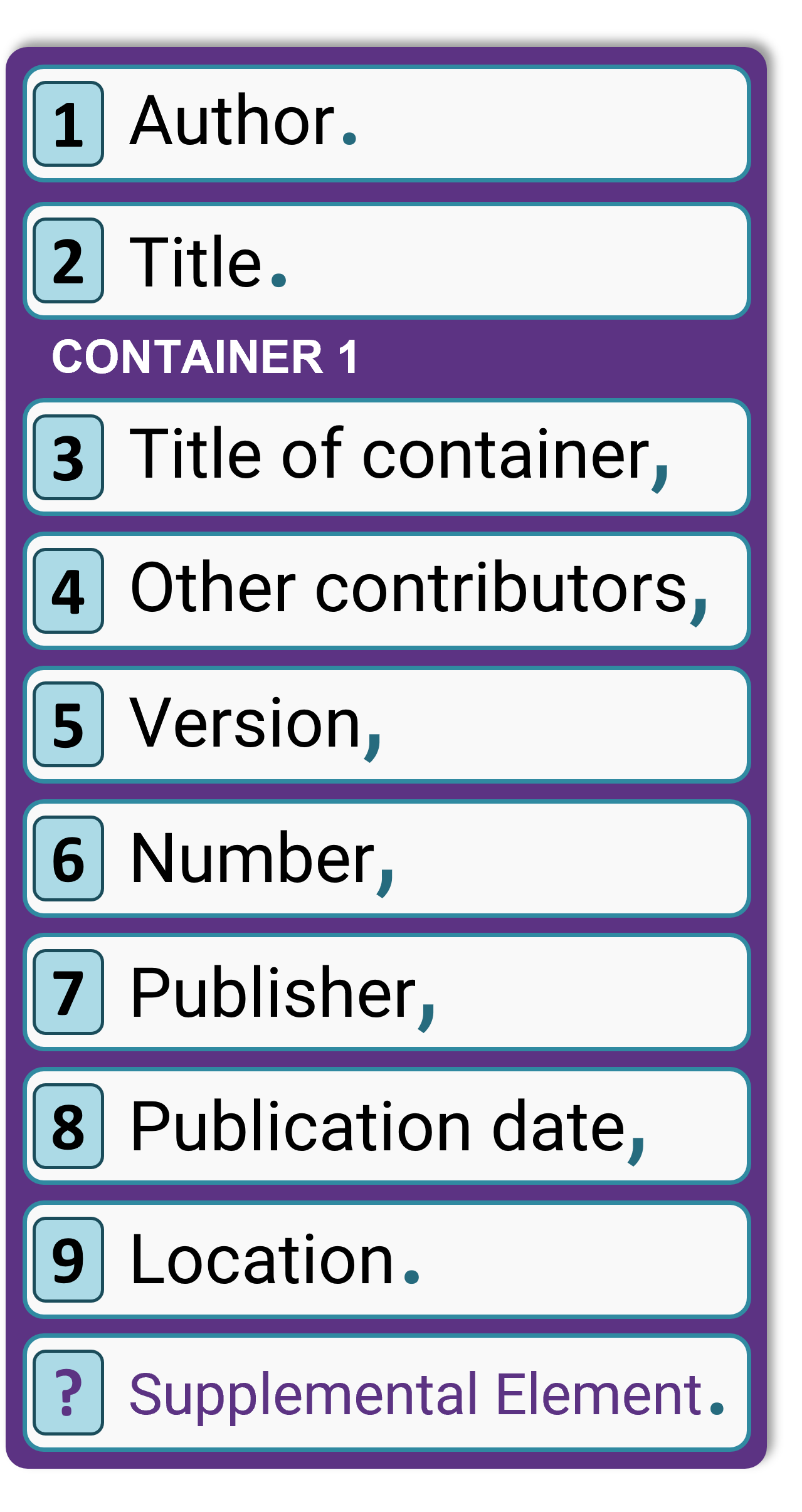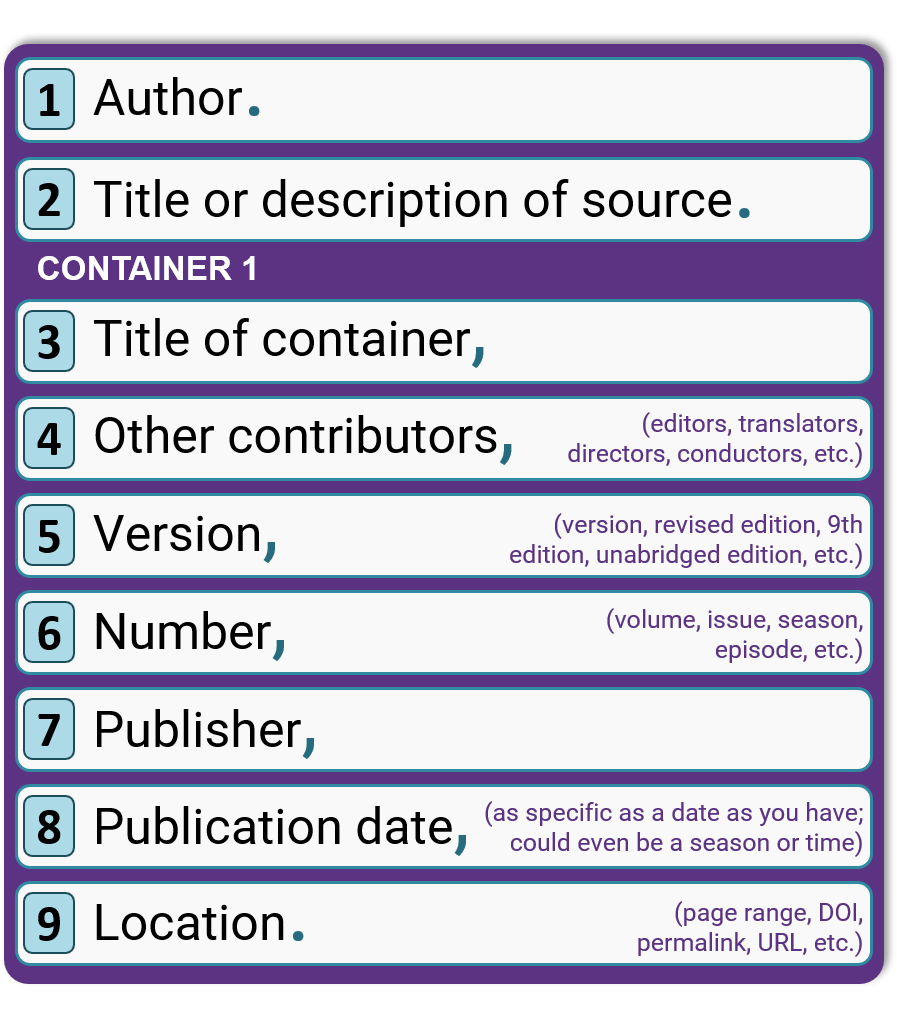Single Author
If you are accessing a print book, then you will need just one container for publication information.
- Minot, Stephen. Three Genres. Pearson, 2003.
Multiple Author Books
If you are accessing a print book, then you will need just one container for publication information.
Two Authors
- Sennett, Richard, and Jonathan Cobb. The Hidden Injuries of Class. Vintage Books, 1973.
More Than Two Authors
For more than two authors: list only the first author followed by the phrase “et al.” (Latin abbreviation for “and others”; no period after “et”) in place of the other authors’ names.
- Smith, John, et al. Writing and Erasing: New Theories for Pencils. Utah State UP, 2001.
Two or More Books by the Same Author
If you are accessing a print book, then you will need just one container for publication information. When you list multiple works by the same author on your Works Cited page, all entries after the first one use three hyphens or three em dashes and a period in place of the author’s name. List alphabetically by title.
-
Young, Dean. Elegy on a Toy Piano. U of Pittsburgh P, 2005.
-
———. Embryoyo: New Poems. McSweeney’s, 2007.
Corporate Authored Books
If you are accessing a print book, then you will need just one container for publication information.
Any articles or legal reference to the organization should be omitted from the name.
-
French Cheese Association. Cheese for Life. Fromage Press, 1996.
Book With No Author
If you are accessing a print book, then you will need just one container for publication information. When you have a book with no author, you should begin with the title of the book.
-
Encyclopedia of Cats. Feline Press, 1991.
A Translated Book
If you are accessing a print book, then you will need just one container for publication information.
-
Marquez, Gabriel Garcia. One Hundred Years of Solitude. Translated by Gregory Rabassa, Harper and Row, 1970.
If your writing is focused on the actual translation work itself, it would be acceptable to cite this same citation as follows:
-
Rabassa, Gregory, translator. One Hundred Years of Solitude. By Gabriel Garcia, Harper and Row, 1970.
Republished Book
If you are accessing a print book, then you will need just one container for publication information. If your source has been republished, the MLA Handbook suggests providing the reader with the original publication date. You should always include the publication date of the source you consulted, but writers with a specialist knowledge of the subject may want to include the original publication date for the reader’s benefit.
-
Thomas, Paul. Boy Trouble. 1982. State Press, 1999.
In the above example, the first date is the original date of publication, and the second is the publication date of the source consulted.
A Subsequent Edition of a Book Prepared by the Author
If you are accessing a print book, then you will need just one container for publication information.
-
Minot, Stephen. Three Genres. 8th ed., Pearson, 2007.
A Subsequent Edition of a Book Prepared by an Editor Who Is Not the Author
If you are accessing a print book, then you will need just one container for publication information.
-
Shelley, Mary. Frankenstein. Edited by J. Paul Hunter, 7th ed., W. W. Norton, 1995.
Anthology or Collection
If you are accessing a print book, then you will need just one container for publication information.
-
Lyons, Paul, editor. The Greatest Gambling Stories Ever Told. Lyons Press, 2002.
An Essay in an Anthology, Reference, or Collection
If you are accessing a print book, then you will need just one container for publication information. To cite a work in an anthology or collection, provide the author and title of the specific work first. Then, provide information for the anthology or collection.
-
Young, Willie. “Knowing the Unknowable.” Poker and Philosophy, edited by Eric Bronson, Carus Publishing Company, 2006, pp. 41-57.
Poem or Short Story Examples from an Anthology or Collection
If you are accessing a print book, then you will need just one container for publication information. To cite a work in an anthology or collection, provide the author and title of the specific work first. Then, provide information for the anthology or collection.
- Coleman, Wanda. “Job Hunter.” For a Living: The Poetry of Work, edited by Nicholas Coles and Peter Oresick, U of Illinois P, 1995, p. 105.
Article in a Reference Book
If you are accessing a print book, then you will need just one container for publication information. If an article in a reference work has no author, you should begin with the title of the article.
-
“Discourse.” The Dictionary of Literary Theory. 2nd ed., Penguin, 1991.
Multivolume Works

MLA requires different formatting depending on how many volumes of a multi-volume work you are referencing for your citation.
Citing Only One Volume
If you are citing just one volume of a multi-volume work, list just that number after “Vol.” as supplemental information at the end of your citation.
-
“On the Heavens.” The Complete Works of Aristotle, edited by J. Barnes, Oxford Translation, Princeton UP, 1971. Vol. 1.
Citing More Than One Volume of a Multivolume Work
When citing some or all of a multivolume set, add up the total number of volumes and include that total with “vols” as a supplemental item at the end of your citation.
-
Lo Kuan-Chung. Romance of the Three Kingdoms. Translated by C. H. Brewitt-Taylor, Tuttle Publishing, 2002, Tokyo. 3 vols.
An Introduction, a Preface, a Forward, or an Afterword
If you are accessing a print book, then you will need just one container for publication information. If there is only a generic name for the section (e.g. Introduction), add it in the title area without quotes or italics.
-
Carter, Billy. Introduction. Southern Beers, Jersey City Press, 1977, pp. 2–14.
If the author of the part cited is different from the author of the book, then write the full name of the complete work’s author after the word “by.”
-
Carter, Billy. Introduction. Southern Beers, by Thomas Budweiser, Jersey City Press, 1977, pp. 2–14.
If the section has a detailed name, use it in quotes. In this situation, you normally do not need to use the generic name.
-
Carter, Billy. “Why I Am Inspired by Hops.” Southern Beers, by Carter, Jersey City Press, 1977, pp. 2–14.
eBooks
 According to MLA, an ebook is defined “as a digital book that lacks a URL and that you use software to read on a personal electronic device.” Most often, this will just require one container. Normally, an ebook is noted within the version element, and the date should use only the year. If an ebook format (e.g. EPUB, MOBI, AZW, PDF) needs to be noted, possibly to indicate formatting for that publication type, it can be added as a supplemental element at the end of the citation.
According to MLA, an ebook is defined “as a digital book that lacks a URL and that you use software to read on a personal electronic device.” Most often, this will just require one container. Normally, an ebook is noted within the version element, and the date should use only the year. If an ebook format (e.g. EPUB, MOBI, AZW, PDF) needs to be noted, possibly to indicate formatting for that publication type, it can be added as a supplemental element at the end of the citation.
-
Nixon, Robin. Learning PHP, MySQL and JavaScript. 4th ed., e-book ed., O’Reilly Media, 2014. EPUB.
-
Wright, Jonathan V., and Lane Lenard. Why Stomach Acid Is Good for You: Natural Relief from Heartburn, Indigestion, Reflux, and GERD. E-book ed., M. Evans and Company, 2012.
NOTES: The OWL’s style guide spells ebook without the hyphen. However, within MLA a hyphen is required (“e-book.”)
In the publishing element, words that relate to the legal status should be removed. However, in the first example, “Company” is part of the name and not reflective of the legal status. The legal name of this publisher is M. Evans and Company, Inc., and Inc. has been removed from the citation.
Elements used in the first citation example are author, title, version, publisher, publication date, and publication format as a supplemental element. Elements used in the second citation example are author, title, version, publisher, and publication date.
The above content has been drawn from the Excelsior Online Writing Lab (OWL). It is published under a Creative Commons Attribution-4.0 International License.
 Remember that not all elements are needed for every book. Only use the elements that are needed for your source.
Remember that not all elements are needed for every book. Only use the elements that are needed for your source.